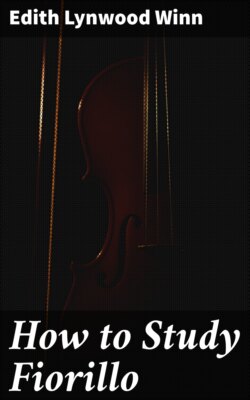Читать книгу How to Study Fiorillo - Edith Lynwood Winn - Страница 9
На сайте Литреса книга снята с продажи.
No. 6.
ОглавлениеTable of Contents
[Listen]
Andante sciolto means about the same as Andante commodo (as slowly as you please). At the middle, or upper half, of the bow, cut the notes lightly and accent trills. The second four measures require grace and ease in the upper half of the bow. Remember to discriminate between the short staccato at the point of the bow and the broader detached stroke. Be very careful of intonation at this point.
[Listen]
The opening measures in the seventh line may be played with a raised bow stroke, middle of the bow. Play near the point of the bow in the last four or five measures of the étude, lightly and elegantly.
Important points to remember in this étude are: Passages bowed near the point are light, as a rule; passages requiring broader bowing are played forte. Always raise the bow slightly for an attack. Each group must be well defined, with accents strong. Pause long enough between the groups to gain poise. Always draw a long bow at the middle with sufficient length to be free and to secure tone. In this exercise, as in many others, the left hand is of most importance. It must be ready. Do not lose time by the trill. Play the single notes freely. These are not staccato. Whenever the staccato occurs in the Hermann edition, as a rule one must play in a broader style. Those old composers did not use the staccato much. Witness Fritz Kreisler playing a work of the period. He gives it more tone-color and varied phrasing than in its period, but he uses very little short staccato work. Number six is a joyous, light work of the French school. It must be technically clean cut, and clear as crystal.
